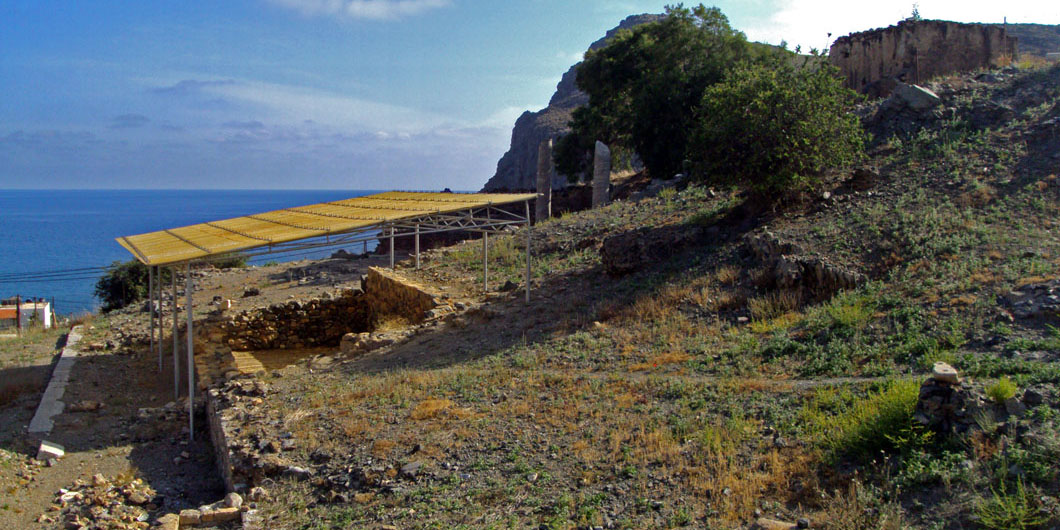Lebena (Levin) was a prosperous ancient town, located at the southern foot of the Asteroúsia mountains, on the shore where the current settlement of Lentas is to be found. Itwas a port of Gortyn, and famous for its Asklepieion, which was visited by worshippers from all over Crete and Libya.

The place name Lebenais probably of Phoenician origin (labi = lion), and the town was probably thus named because of a peninsula which resembles a lion’s head, located west of it.
The area was first inhabited during the Final Neolithic years. Considering the numerous archaeological finds discovered in the Proto-Minoan graves which were excavated in the area, a settlement flourished there in the Proto-Minoan period; it seems that this settlement had already established, back then, trading relationships with Egypt, the East and the Cyclades.
The town, however, reached its peak during the Hellenistic and mainly the Roman years, when Gortyn had risen to be the most powerful city of Crete.
Lebena was its port, and also the place chosen by the Gortynians to establish a sanctuary of Asklepios, in the 4th century BC, similar to the Asklepieion of Epidaurus.
This sanctuary, where Asklepios and Hygeia were worshipped, was built at a therapeutic thermal spring. It was a famous centre for hydrotherapy andphysiotherapy, and it also functioned as a sanatorium.
In the mid 1st century AD, the area was shaken by a massive earthquake, which utterly destroyed the sanctuary and a large section of the town. It is mentioned that the shoreline changed because the sea then regressed more than 1 kilometre (7 stadia = 1.296,05 metres). However, the town was rebuilt and continued to be a very important trade centre, for several centuries.During the First Byzantine period, two noteworthy basilicas were erected in Lebena, traces of which can be seen today. The settlements in the area were deserted as a result of the continuous pirate raids that took place during the 7th century AD, a precursor of the subsequent Arab occupation.

The area may have not an organised archaeological site, however traces of its past are clearly visible in and around the present-day settlement of Lantas; the Asklepieion, which was built on a man-made platform, with a majestic stairway leading onto it, stands out among them. The platform was covered with marble slabs, and its perimetre was decorated with a mosaic. The surviving walls of the temple were built with bricksand were faced with white marble. Two tall marble columns can also be seen, and a 6 metre long base, which held the statues of Asklepios and Hygeia, is preserved at the western wall. Unfortunately, these statues were shattered several decades ago, by local peasants who believed that a treasure was hidden in them.
North of the sanctuary there was a large gallery (stoa) in which the quarters of the priests and the avaton (= place or room where access was restricted or forbidden) of the sanctuary possibly existed.
Only inpatients could enter the avaton, and they did so in order to sleep; as it was believed, after a deep night’s sleep, during which they expected to see therapeutic dreams, they would wake up with their health restored.
A fountain was found at the eastern side of the sanctuary; it probably marked the middle section of an earlier phase of the sanctuary, and the exact location of the therapeutic spring over which the fountain was built. Another important archaeological find is the treasury, which is situated at the western gallery of the sanctuary. Underneath the floor,another mosaic floor was found,divided in two sections; one section depicts a hippocampus framed by a repeated spiral design, and the other one represents two palm trees.
This floor safeguarded an underground apartment, which was sealed by a covering with a lock. This covering was found inside the crypt, broken, vandalised by looters of the Late Roman period or the Byzantine years. According to an inscription, all votive offerings to god Asklepios were kept inside this crypt.
An Early Byzantine basilica of the 5th or the 6th century AD was unearthedeast of the Asklepieion. It had three aisles, a wooden roof and a narthex, for the construction of which materials from Hellenistic and Roman buildings were used. The basilica itself was initially built in the mid 5th century AD, destroyed in the mid 6th century and then rebuilt, in the same size and form.



